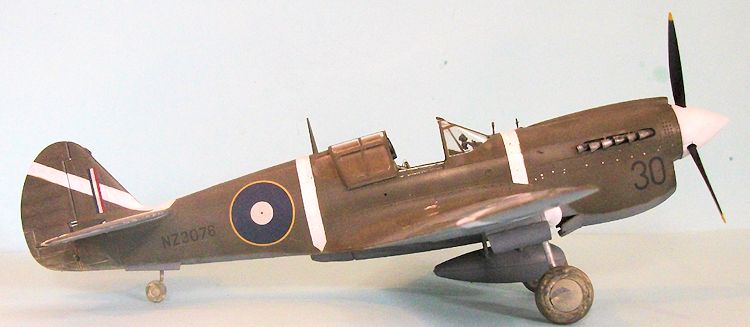
Hasegawa 1/32 P-40M Kittyhawk III
| KIT #: | 08199 |
| PRICE: | $75.00 SRP |
| DECALS: | Two options |
| REVIEWER: | Tom Cleaver |
| NOTES: |

| HISTORY |
The P‑40M was similar to the preceding P‑40K series, with the primary visual
difference being a cooling inlet on each side of the nose ahead of the exhaust
stacks, and a radio antenna mast.
Like the late‑series P‑40K, it was powered by an Allison
V‑1710‑81 engine.
The 600 P‑40Ms produced were almost all destined for
Lend‑Lease, and the airplane was known in the RAF and the Commonwealth Air
Forces with whom it served as the Kittyhawk III.
The RNZAF and the P-40M/Kittyhawk III.
The RNZAF had its first contact with the Curtiss P‑40 when 80 P‑40E‑1 "Kittyhawk
Is" were delivered in April and May 1942.
Number 14, 15, and 16 Squadrons were formed on the
Kittyhawks and undertook training through the rest of the year. In early 1943,
the New Zealanders received U.S. P-40M Warhawks.
These American aircraft, painted in Olive Drab and
neutral Grey and still equipped
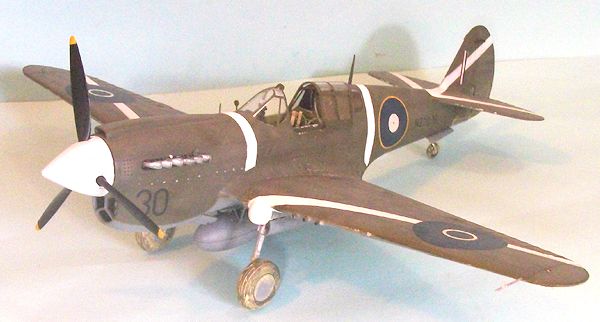 with U.S.
seatbelts, were known unofficially to the RNZAF as “Kittyhawk III”, though
pilots called them P-40s.
Shortly after equipping with these new P-40s, the
aircraft and their pilots were sent to Vanuatu in the New Hebrides, where the
aircraft were reassembled and flown on to Espiritu Santos the main allied base
in the South Pacific.
with U.S.
seatbelts, were known unofficially to the RNZAF as “Kittyhawk III”, though
pilots called them P-40s.
Shortly after equipping with these new P-40s, the
aircraft and their pilots were sent to Vanuatu in the New Hebrides, where the
aircraft were reassembled and flown on to Espiritu Santos the main allied base
in the South Pacific.
15 Squadron was
the first to enter combat on Guadalcanal, arriving at Kukum Field (Fighter II)
on April 8, 1943, the day after the last great Japanese raid on the island, in
which over 40 Japanese aircraft had been shot down by the Navy and Marine
defenders.
15 Squadron undertook escorts of RNZAF Venturas on reconnaissance
flights in the Solomons, and scored their first success on May 6, when the
squadron commander shot down an A6M‑2N during a rainstorm.
14 Squadron
arrived at Kukum on June 10, and 15 Squadron returned to Espiritu Santos shortly
thereafter, having claimed an additional three Zeroes shot down near the Russell
Islands on June 7.
14 Squadron’s tour lasted until July 24, with 16
Squadron arriving on the 20th and
taking over operations on July 25 when 14 Squadron rotated to the rear.
By chance, 14 Squadron’s tour of duty had coincided with
a major aerial challenge by the Japanese as the Allies prepared to invade New
Georgia, providing the pilots of the squadron with the opportunity to establish
themselves as the leading scorers in the P-40 with the RNZAF.
Among the pilots
of 16 Squadron was Lyn William Williams, 27, a sheep farmer from an established
old colonial family in the province of Taranaki, New Zealand who had been in the
country since arriving in 1841 from Wales. He had inherited the family farm
shortly before the outbreak of was in 1939, and through the “essential
industries” clause could have avoided service since supplying food to Britain
was seen as vital at the time. However, both Lyn and his younger brother Reeve
became pilots, with Reeve going to the Fleet Air Arm after elementary flying
training in New Zealand, where he eventually became a German POW. Lyn Williams
was by all accounts a friendly, athletic guy who excelled at tennis and snow
skiing.
 On July 31, 1943, almost a week after their arrival on operations, 16 Squadron
RNZAF took off from Kukum Field to patrol the Munda area, including New Georgia
Island.
So far, the squadron had not had many run-ins with the enemy, outside of
some small interception flights from fields on the islands bordering “The Slot”
as the P-40s escorted Kiwi Venturas and American Dauntlesses and Avengers
striking Munda. Among the pilots on the flight was Flight Sergeant Lyn Williams
in P-40M/Kittyhawk III NZ3076.
The weather was cloudy with building cumulus over the
ocean.
F/Sgt Williams and his wingman F/Sgt Sam Sharpe broke through the cloud
cover at 20,000 feet and spotted another section of P40’s under attack by Zeros.
Williams led the two in to assist and they were in turn attacked by a larger
formation of Zeros with a large altitude advantage, which fell on top of them
from out of the sun. The two Kiwi pilots were immediately fighting for their
lives.
On July 31, 1943, almost a week after their arrival on operations, 16 Squadron
RNZAF took off from Kukum Field to patrol the Munda area, including New Georgia
Island.
So far, the squadron had not had many run-ins with the enemy, outside of
some small interception flights from fields on the islands bordering “The Slot”
as the P-40s escorted Kiwi Venturas and American Dauntlesses and Avengers
striking Munda. Among the pilots on the flight was Flight Sergeant Lyn Williams
in P-40M/Kittyhawk III NZ3076.
The weather was cloudy with building cumulus over the
ocean.
F/Sgt Williams and his wingman F/Sgt Sam Sharpe broke through the cloud
cover at 20,000 feet and spotted another section of P40’s under attack by Zeros.
Williams led the two in to assist and they were in turn attacked by a larger
formation of Zeros with a large altitude advantage, which fell on top of them
from out of the sun. The two Kiwi pilots were immediately fighting for their
lives.
The RNZAF P40
squadrons acquitted themselves well in the Solomons campaign, being credited
with 99 confirmed and 13 probable kills, for the loss of only 20 aircraft.
U.S. Navy and Marine Corps aircrew in Dauntlesses and
Avengers welcomed the close escort provided by the New Zealanders, who were
proud of the fact they never lost an aircraft they were assigned to cover.
The engagement
in which Williams was lost is mentioned in several books: “Kittyhawks and
Coconuts” (1995) by Keith Mulligan, pages 86 & 87, the author was himself a 16
SQDN P40 pilot who knew Lynn Williams and took part in the action that day; “The
Blue Arena” (1986) by SQDN LDR Bob Spurdle DFC & bar, Page 149; and “Wings over
the Pacific, The RNZAF in the Pacific Air War” by Alex Horn (1992). Pages 65 &
66.
| THE KIT |
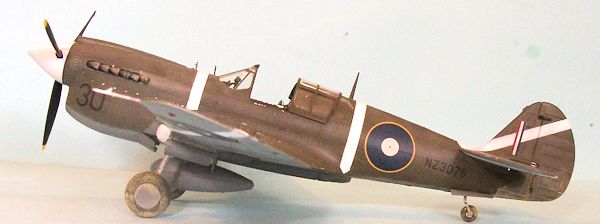
| CONSTRUCTION |
These kits are
the essence of simplicity.
I started by painting all the interior parts for the
fuselage with Xtracrylix Interior Green.
While that was drying, I attached the left and right
rear fuselage parts to the respective forward fuselage parts, as well as the
exhaust panels. I then applied a thick coat of Tamiya’s “Mr. Surfacer” to the
fuselage joint.
When that was dry, I sanded it smooth and rescribed the panel
lines and the rivet detail.
I also attached the horizontal stabilizers and rudder.
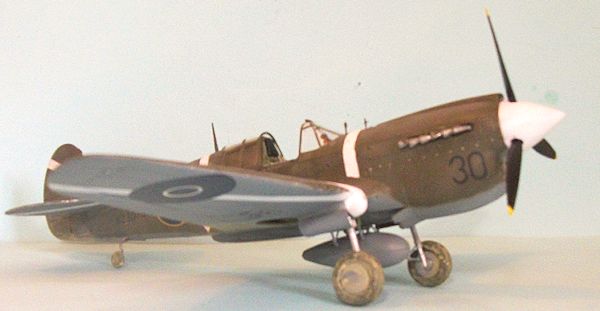 disappeared
and then rescribed.
disappeared
and then rescribed.
| COLORS & MARKINGS |
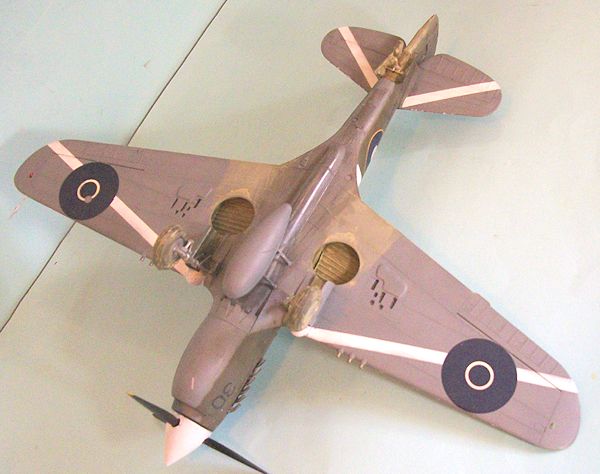 until 1943.
The paint was then progressively lightened with Tamiya
“Khaki Light”, “Sky Grey” and “Flat White” in succeeding passes over the model
to get the subtle sun-fading that is associated with aircraft in the South
Pacific.
In the case of this particular airplane, which had not been long in the
Solomons at the time of its loss, this fading was not done as obviously as for
other aircraft subject to this weathering for a longer period.
This may not be that apparent in the photos, but it is
there very subtly in person.
The result looked very close to the photos of the actual
airplane that Hugh Thomas pointed me to.
I finished off by painting the spinner white.
When all was dry, the stripes were unmasked and the
model was given two coats of Xtracrylix Gloss varnish.
until 1943.
The paint was then progressively lightened with Tamiya
“Khaki Light”, “Sky Grey” and “Flat White” in succeeding passes over the model
to get the subtle sun-fading that is associated with aircraft in the South
Pacific.
In the case of this particular airplane, which had not been long in the
Solomons at the time of its loss, this fading was not done as obviously as for
other aircraft subject to this weathering for a longer period.
This may not be that apparent in the photos, but it is
there very subtly in person.
The result looked very close to the photos of the actual
airplane that Hugh Thomas pointed me to.
I finished off by painting the spinner white.
When all was dry, the stripes were unmasked and the
model was given two coats of Xtracrylix Gloss varnish.
I gave the model
several coats of Xtracrylix Flat varnish, then ‘dinged” it lightly with Tamiya
Aluminum - photos of the airplanes of 16 Squadron show they were not all that
worn at the time of this loss.
I used Tamiya “Smoke” for the exhaust and oil stains.
| CONCLUSIONS |
I am quite happy
that this model will soon be sitting in the home of Hugh Thomas, Lyn Williams’
grand nephew, who commissioned this project to memorialize his ancestor,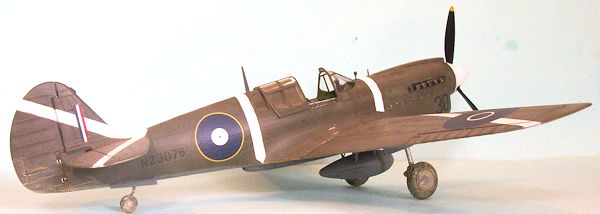
Past that, it’s
a Hasegawa P-40 - what’s not to like?
The kit is no longer in production, but can be found
from dealers on eBay for prices no more inflated than what Hasegawa is charging
now.
These kits are simple enough in execution and so well-designed that it
is virtually impossible not to get everything assembled with proper alignment,
so that any modeler can attempt a project with it with the prospect of having a
nice model as a result.
The kit markings are excellent and provide an
opportunity to do an airplane that has not been “done to death” by the decal
manufacturers, whichever markings option is chosen.
The result is a model that is a “big canvas” for a fun
project.
Highly recommended.
May 2013
Thanks to Hugh Thomas for the review kit.
If you would like your product reviewed fairly and fairly quickly, please contact the editor or see other details in the Note to Contributors.